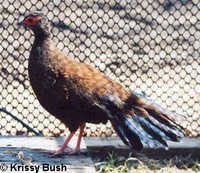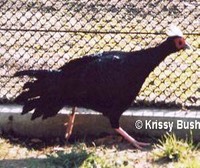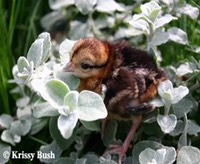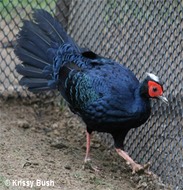Scientific Information
Class: Aves
Order: Galliformes
Family: Phasianidae
Subfamily: Phasianinae
Genus: Lophura
Species: Lophura edwardsi
Species English name: Edwards Pheasant
CITES Status: CITIES I - endangered
Distribution: Vietnam
(from A Monograph of Pheasants Volumes I & II, William Beebe)
Description
• Male - Body is black with a metallic blue hue. Crest is white. Wattles are red and legs are pinkish red.
• Female - Body is auborn-brown. Flight feathers and tail are a darker brown. Wattles are red and legs are pinkish red.
Diet
• We feed our breeders and young adults 16% layer pellets, our tiny chicks 25% Turkey Starter crumble, and our growing chicks 20% crumble.
• They get a handful of mixed grains every second day except during breeding season, fresh greens (lettuce, chickweed, dandelions, grass) and ruits (tomato, grapes, berries, etc.) when available.
Breeding
• Done in pairs.
• Edwards are classically second year birds with the female laying eggs in her second year and the males not being fertile until the second or third year. Since the infusion of English stock to our lines, Edwards males are almost always fertile in their first year and the many females will lay in her first year.
• They usually start laying eggs at the end of March to the beginning of April and will lay every second day until they lay approximately 1 - 6 eggs. A later batch of eggs a few weeks later is common. An average amount of eggs is 6-12.
• They lay a round pink egg with cream speckles.
Incubation
• Eggs are collected twice a day and marked with the date and breeding pen number and set daily.
• Eggs are set in an automatic turning Lyons Roll-X (RX2) with grid 109.
• Temperature 99.8°F, humidity-wet bulb 84 with humidity adjusted periodically depending on development of the air space shown by candling
• On the final day of incubation, each egg is placed in its own oval wire mesh hatching basket (6" x 3" x 3") and set in the Sportsman Rattite hatcher.
• Incubation for Edwards is 24 days.
• After the chick hatches, it stays in the hatcher for a minimum of 8 hours.
Chicks
• Chicks are very quiet and sedate. They often look sleepy and are not nearly as active as other chicks. They have a dark brown body, and auburn brown crown and neck, a tawny chest, belly and face, and a black eye streak. They are very cute chicks that do not mind being picked up. An interesting feature of the chicks is that they think that you can not see them and you can therefore pick them up very easily.
• They start out in our round 18" brooder pen with a mixed assortment of chicks. After a few days they are separated into a 2' x 4' baby pen for about a week. They are then transferred to an Edwards-Swinhoe or Edwards-Grey Peacock 2' x 6' pen for the next 7-9 weeks. They stay with this grouping until they go outside. All of these brooding pens have wire bottoms with a heat lamp at one end and feed & water at the other end. The heat lamp is attached to a dimmer switch so we can turn down the amount of heat as the chicks get older until it is turned off completely.
• After they are off of the heat for a few weeks, they are moved outside to the pheasant house (has outside grassy pens and a heated inside house part where they are blocked in for the night). At this point they are separated into an all Edwards pen. After they are toughened up, they are moved to an outside chick pen.
• Chicks are very easy to raise with their own kind. Since they are so quiet and will not defend themselves, they can only be kept with docile non-violent chicks like Swinhoe or Grey Peacocks.
Pens
• We keep our Edwards in the pheasant house during the breeding season. The inside portion of the pens are approximately 5' x 5' and the outside portion of the pens is 5' wide and 12' long. Out side runs have grass and the inside is covered with a thick layer of straw.
• Summer pens are 25' long x 10' wide x 6' high with a 4' x 4' x 4' house in the middle.
• Pens are covered with 2" diamond top-rite.
• Pens contain grass, which needs to be mowed every few weeks to a month because they aren't very hardy grass eaters.
• See Scintillating Copper Article for predator proofing set-up
Behavior
• Are calm and very quiet birds. Spend most of the time inside of the house or hiding in the grass. They enjoy dusting or sunning themselves in the summer. They are a very showy bird with an interesting personality.
• They can be tamed, but prefer to ignore humans.
Article By Krissy & Donna Bush
Pheasant Ridge



